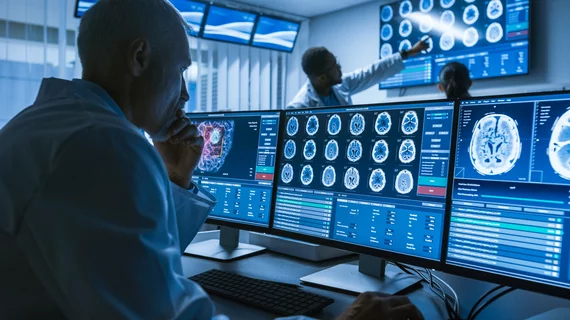Academia still lagging behind private practice in allowing radiologists to read remotely
The COVID-19 pandemic pushed academia further into the world of remote reading. However, universities are still lagging behind private practices in the use of teleradiology, with potential hiring implications, according to survey data published Tuesday in JACR [1].
Roughly 30% of academic radiologists said their organization allowed them to work remotely before the pandemic, compared to 65% in other settings. But about 67% in academia said that changed with the arrival of COVID-19, while 33% in other settings said their organization first started allowing for remote reading during this time.
Some, however, are beginning to revert back to how things were before March 2020. About 35% of academic organizations have decreased the amount of remote reads conducted in the past year compared to 5% in other settings, the survey found. And about 27% of academic rads said they are expected to report back to on-site reading from their remote work, versus 8% for those in private practice.
“Since academic departments are more likely to have radiologists return to on-site work, the degree of remote reading could become a factor that recently trained radiologists consider when deciding between pursuing an academic versus a private practice career,” Easton Neitzel, with the Department of Radiology at the University of Arizona College of Medicine in Phoenix, and colleagues wrote June 27. Backing this claim, they cited a 2021 study, which found that 77% of rad residents with remote workstations indicated they would be interested in a job that offers this option in the future.
Four radiologists and a medical student created the online questionnaire, hoping to gauge the specialty’s perception of remote reading in relation to the pandemic. Experts at the American College of Radiology further refined the survey prior to its distribution to 7,400 ACR members in summer 2022. A total of 345 radiologists completed the questionnaire, for a response rate of 4.7%.
About 91% of all respondents said their organization enabled remote reading amid the pandemic. Of those, 53% had this perk prior to COVID-19, and 44% said it first started with the pandemic’s arrival. Another 84% of those who have read remotely believe this will remain a permanent change to their organization’s workflow post-pandemic. Many indicated they will likely work in a hybrid model, with no notable differences in responses between academia and private practice.
Radiologists cited improved lifestyle (81%), no commute (76%) and fewer interruptions or distractions (68%) as some of the biggest positives of working remotely. Meanwhile, a decreased sense of camaraderie was named as the No. 1 downside, followed by lack of consultation with colleagues (44%) and increased isolation (41%). Of the same group, 87% said remote reading had a positive impact on job satisfaction, while 8% felt neutral and 5% viewed the change negatively.
“Academic radiology departments must balance the advantages of remote reading with its potential drawbacks, perhaps most importantly because of the impact on radiologic training,” Neitzel et al. wrote. “At one academic institution, 81% of first- and second-year radiology residents reported that remote work during the pandemic had either a negative or very negative effect on their education,” they added, citing the same 2021 study from Current Problems in Diagnostic Radiology.
Read much more from the survey, including potential limitations, in the Journal of the American College of Radiology at the link below.

